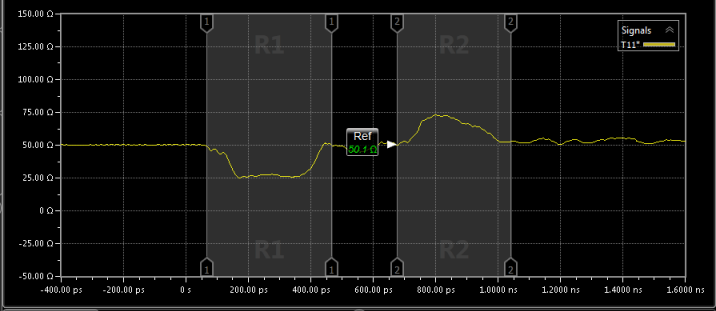:MEASure:TDR:ECAPacitance
Command Syntax
:MEASure:TDR:ECAPacitance
Query Syntax
:MEASure:TDR:ECAPacitance?
Description
 Measures Excess Capacitance on a portion of the TDR time-domain waveform as shown in the following figure. The excess capacitance is returned in Farads. The waveform can be displayed on any of the following content windows:
Measures Excess Capacitance on a portion of the TDR time-domain waveform as shown in the following figure. The excess capacitance is returned in Farads. The waveform can be displayed on any of the following content windows:
- Waveform
- Time-Ohms
- Time-Volts
- Time-%
The response area over which the excess capacitance is to be measured must first be placed within a measurement region, as this measurement does not work over the entire display. Use the following commands to setup the measurement region:
- :MEASure:REGions:STATe to turn regions on.
- :MEASure:REGions:REGion:X to position a region on the response.
- :MEASure:ECAPacitance:REGion. If multiple measurement regions are displayed, selects the region over which the measurement is made.
- :MEASure:ECAPacitance:SOURce selects the TDR time-domain response on which to perform the measurement. For example, T11(Ω) or CHAN1A.
- :MEASure:ECAPacitance:REFerence:TYPe selects the portion of the response to used as the measurement reference: left, right, nominal, or custom.
- :MEASure:ECAPacitance:REFerence:VALue to enter a custom reference impedance.
To measure excess inductance, use the :MEASure:TDR:EINDuctance command.

Shunt capacitance is negative going. Series inductance is positive going.
When measuring discontinuities on lines, whose impedance is not 50Ω, the excess reactance measurement is still valid as long as the 50Ω measurement system is connected to the non 50Ω line without using matching resistors.
Requires FlexDCA revision A.04.00 and above.
Measurement Ready?
To confirm that the measurement is ready to read, you can query the measurement's status:
if ('CORR' in Flex.query(':MEASure:TDR:ECAPacitance:STATus?')):
measurement = Flex.query(':MEASure:TDR:ECAPacitance?')
If averaging is turned on (:ACQuire:AVERaging), you can also confirm if the measurement result is ready by comparing the number of specified averages (:ACQuire:ECOunt?) versus the number of measurement sweeps that have occurred (:MEASure:TDR:ECAPacitance:COUNt?). The technique uses the :COUNt? common measurement query. For example,
if (Flex.query(':MEASure:TDR:ECAPacitance:COUNt?') >= Flex.query(':ACQuire:ECOUNt?')):
measurement = Flex.query(':MEASure:TDR:ECAPacitance?')
You can also use an acquisition limit lest to test that a number of waveform samples, or pattern acquisitions have completed before returning a measurement. Refer to the :LTESt:ACQuire:CTYPe command.
Common Measurement Child Queries
This command supports the use of the following common measurement queries: :LOCation?, :COUNt?, :MAXimum?, :MINimum?, :MEAN?, and :SDEViation?.
Measurement Identification
Avoid subtle programming errors! To ensure that the correct measurement is installed or queried, always explicitly identify a measurement when installing a measurement or querying a measured value, status, or detail. To identify a measurement, specify the measurement's source waveform (:SOURce child command). With some measurements, you may also need to specify other identifying values. Generally, when selecting a measurement using FlexDCA's GUI, if a dialog appears prompting you to select values, you should explicitly specify these values when remotely identifying the measurement. More information.
For example, to return the status of the measurement, :MEASure:TDR:ECAPacitance:
flex.write(':MEASure:TDR:ECAPacitance:SOURce CHAN1A')
if flex.query(':MEASure:TDR:ECAPacitance:STATus?') == 'CORR';
measurement = flex.query(':MEASure:TDR:ECAPacitance?')
else:
details = flex.query(':MEASure:TDR:ECAPacitance:STATus:DETails?')
reason = flex.query(':MEASure:TDR:ECAPacitance:STATus:REASon?')
Child commands for measurement identification:
:MEASure:TDR:ECAPacitance:SOURce:MEASure:TDR:ECAPacitance:REGion